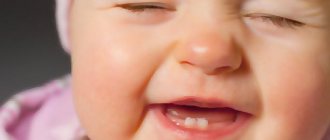What does healthy baby stool look like?
The baby's bowel movements depend on the type of feeding. A baby's first stool is called meconium. It is usually dark in color with a greenish tint. Meconium appears during the first two to three days of life.
When breastfeeding, a baby's normal stool has the following characteristics:
- Consistency ranges from creamy to liquid.
- Color from yellow to greenish.
- The smell is sour milk.
- There may be traces of undigested milk.
- The number of bowel movements ranges from 1 to 7. Usually after each feeding.
With artificial feeding, the stool is mushy, with the usual smell of feces.
Feces and its features in children of the first month of life
A newborn with diarrhea can be calm
What constitutes the basis of a newborn baby's diet? This is breast milk or adapted formula. These foods are liquid and therefore the stool contains more water than the feces of an adult.
The nature of feces in a baby of the first year of life:
- The first and second days after birth, the stool is black, viscous and sticky. Defecation several times a day. This is meconium and such bowel movements are normal.
- The third day and before the introduction of complementary foods - the feces are yellow and soft, watery. Sometimes you come across curdled pieces in small quantities. Bowel movements occur several times a day.
If the baby uses an adapted formula, the color of the stool may have a greenish or black tint. Typically, formulas are fortified with iron to prevent anemia. This is what gives stool such an unpleasant tint. After the introduction of complementary foods and with the expansion of the diet, the color of feces gradually becomes similar to the feces of an adult. Bowel movements occur 1–2 times a day.
If your baby passes liquid stool, but is not worried, eats well, gains weight, actively plays and develops according to age standards, then there is nothing to worry about. After switching to a more adult diet, the feces will become denser and will delight the parents.
Signs of diarrhea
The manifestations of diarrhea in infants with breastfeeding and artificial feeding are the same. The child's behavior may change, and the number of bowel movements noticeably increases. What does diarrhea look like in a baby:
- the color of the stool changes, stool may become green or unnaturally yellow;
- the consistency may become noticeably thinner, down to water;
- there is mucus and blood in the stool;
- unpleasant “rotten” smell of stool.
The listed signs of diarrhea in a breastfeeding baby may be accompanied by fever, vomiting, and increased gas production. The child’s behavior indicates pain in the abdomen: the baby begins to be capricious and tuck his legs. It is important to distinguish vomiting from regurgitation. The latter happens after feeding or excessive activity. Vomit, on the contrary, comes out with pressure, a fountain, vomiting occurs spontaneously and is not associated with the feeding regimen.
How to distinguish loose stools from diarrhea
Loose stools are not always a pathology
You can distinguish normal loose stools from pathological ones by several signs:
- Significantly increased number of bowel movements
- Thinner, waterier stool consistency
- Stool comes out in a sudden burst
- The smell becomes more pronounced, sour
- The stool turns green
- Blood, foam or mucus may be found in the stool.
It is important to monitor the general indicators of the baby's condition. Deterioration of appetite and sleep, formation of gas, colic, increased temperature, capricious behavior of the baby are alarming signs.
Causes of diarrhea in babies
To understand what to do if a baby has diarrhea, it is necessary to determine its causes. A pediatrician can do this. The most common causes of diarrhea in infants during breastfeeding include:
- Changes in the diet of a nursing woman: eating fatty foods, large amounts of fresh vegetables and fruits, dairy products.
- Lactose or gluten intolerance in newborns. If there is a lack of digestive enzymes in the baby's stomach, diarrhea may occur. This happens if the mother’s menu includes products to which the baby is allergic: milk or cereal products.
- Reaction to a new product that a nursing woman introduced to her menu.
Yellow diarrhea in a baby caused by changes in the mother's diet goes away quickly and does not require special treatment. After restoring the diet, the digestion process returns to normal. Among the main causes of diarrhea in a bottle-fed baby, as a rule, are the addition of a new formula for feeding, as well as a premature transition to natural milk.
When complementary foods are introduced, the child's digestive system adapts to new, more complex foods. The color and consistency of the stool changes, it becomes more formed, and acquires a characteristic odor. Diarrhea in a mixed-fed baby can be a response of the body to the introduction of complementary foods - the digestive system is just adapting to such food, so it will take time for the baby’s gastrointestinal tract to function normally.
The digestive system of an infant continues to develop in the first months of life. During this period, she is especially vulnerable to viruses and microbes that can cause serious illnesses accompanied by diarrhea.
Infectious causes of diarrhea
Green diarrhea in an infant indicates intestinal dysbiosis and the presence of pathogenic microflora.
Diarrhea may be caused by:
- bacterial intestinal infections, for example, salmonellosis, ischerichiosis;
- viral infections, such as rotavirus.
Despite the fact that parents carefully keep the house clean and sterilize pacifiers and dishes, the child still remains vulnerable to intestinal infections. Infection can occur as a result of contact with sick people and their things, or by eating fruits and vegetables that are not washed well enough.
A sign of an intestinal infection, in addition to diarrhea with mucus, in infants is general intoxication of the body. It is accompanied by fever, vomiting, chills, and headache. Manifestations may vary depending on the severity of the disease. Sometimes a baby vomits without fever or diarrhea.
Rotavirus
Rotavirus is a viral disease that is especially dangerous for children under one year of age. Manifestations of the disease are similar to food poisoning and intestinal infection. The main danger is associated with dehydration, which can threaten the baby's life.
Physiological diarrhea in a child
Diarrhea in a child may occur due to changes in climatic conditions.
Doctors have a definition of “physiological diarrhea,” which is quite common in young children for various reasons, such as:
- teething;
- changes in climatic conditions;
- the body's response to the introduction of a new food product.
With “physiological diarrhea,” the child behaves as usual: sleeps peacefully, is active, and does not cry for no apparent reason.
This situation is the norm; usually diarrhea goes away quickly without medical help; you can, perhaps, make adjustments to the diet of the mother and child (if he is already eating complementary foods).
But if symptoms such as vomiting and fever appear, then immediately consult a doctor to prevent complications.
Treatment of diarrhea in newborns
When the first signs of diarrhea appear, you should immediately consult a doctor. Based on the diagnosis, the pediatrician will determine how to treat diarrhea in an infant. The main task of parents is to prevent disruption of the water-salt balance in the baby’s body. The following measures are aimed at this:
- continuation of natural feeding at the request of the newborn;
- drinking water from a spoon in small, frequent portions;
- the use of drugs that help maintain the body’s water-salt balance;
- taking antiviral drugs, sorbents, as well as drugs aimed at restoring the normal functioning of the newborn’s intestines.
Diarrhea in an infant should never be ignored, as its consequences can be serious. In case of severe diarrhea, it is necessary to contact a specialist on the first day of the disease.
What is diarrhea
Diarrhea in a child occurs due to the introduction of a new food product.
On what principle does the protective mechanism of diarrhea work? The mucous substance produced by intestinal cells has a protective function for the body against pathogenic bacteria and viruses.
When these microorganisms enter the internal environment of the intestine, they begin to attack the intestinal walls, destroying the cells that produce protective mucus.
As a result, the human body cannot cope with the production of the required amount of mucus, and some parts of the intestine remain unprotected.
Toxins released by a virus or bacteria enter such “weakened” areas of the intestine and affect it. The human body, trying to protect itself, begins to release large amounts of water to flush out toxic substances.
Lactase deficiency
If your child has frequent, watery, foamy stools with a sour odor, he or she may be lactose intolerant. Lactose is milk sugar, making up about 99% of all carbohydrates in any milk, including human milk. A special enzyme, lactase, is responsible for the breakdown of lactose. If for some reason the activity of this enzyme is reduced (so-called lactase deficiency ), excess undigested lactose leads to diarrhea.
The simplest and most accessible test for suspected lactose intolerance is to determine the amount of carbohydrates in the stool.
For proper treatment, it is necessary to find out the cause of intolerance, be sure to consult with a pediatric gastroenterologist and, possibly, an allergist. If a child has received breast milk, he is not deprived of this beneficial product. As a rule, it is recommended to express about 1/4-1/3 of the volume of one feeding and add lactase ( an enzyme that breaks down lactose) to the expressed milk. At the beginning of feeding, the baby should be given expressed milk with lactase , and then supplemented from the breast. The dosage of the enzyme is selected by the doctor individually.
If the child is on artificial or mixed feeding, then the adapted milk formula is either replaced with a low-lactose or lactose-free formula (it is also better to consult a doctor about the selection of a medicinal formula), or a lactase is added to the regular milk formula and incubated for some time before feeding.
As children grow older, the activity of the lactase increases and the symptoms of lactose intolerance completely disappear.
Intestinal infections
Intestinal infections are quite common in infants. Even the most careful and clean parents cannot always avoid the development of an intestinal infection in their baby. The fact is that the protective functions of the intestines (acidity of gastric juice, local immune factors) in infants are not yet fully formed, and some pathogens that are not dangerous for adults can cause serious disorders in an infant.
As a rule, the infection begins suddenly - with abdominal pain (the child cries, kicks his legs) and diarrhea (sometimes with inclusions of mucus, greens, blood and other impurities). Intestinal infections may be accompanied by a rise in temperature, but this does not always happen. If any of the described symptoms appear, be sure to call a doctor, and before he arrives, try to alleviate the child’s condition with the following measures:
- With loose stools, the child loses a lot of water and salts, and he may become dehydrated. To prevent this from happening, the baby must be given one of the saline solutions - for example, Oralite, Rehydron. The drug enterodez, in addition to salts, also contains activated carbon, which adsorbs toxins from the intestines. One of these drugs should be kept in your home medicine cabinet at all times. It is very important to completely replace the child with the volume of fluid that he loses through stool and vomiting (it is advisable to measure this volume). If the baby does not drink from a bottle, liquid can be given from a spoon or even from a pipette - small portions of liquid do not provoke vomiting as much as large ones. It is not advisable to give your child regular boiled water, since a lot of salts are lost with intestinal contents - if you give liquid without salts, this deficiency will worsen.
- In addition to fluid replenishment solutions, the child can be given adsorbents (smecta, polyphepan, enterosgel) - drugs that, like a sponge, absorb toxins contained in the intestines. But keep in mind that while these drugs absorb toxins, they do not destroy pathogenic bacteria. In large quantities they can lead to constipation.
- Should I feed my child in the midst of an intestinal infection? Yes, feed. But the amount of food per day should be reduced by 1/3-2/3 compared to normal (depending on the maximum amount of food that does not lead to vomiting). If the child is breastfed, then continue to feed him breast milk; in such situations, it is better to give artificial milk formulas to artificial babies. Feed more often, but in small portions. You can add 1/4 tablet of the enzyme preparation Mezim-Forte to each feeding. Here, perhaps, are all the measures that can be taken before the doctor arrives.
- Never give an infant antibiotics without a doctor's prescription: some of the antibiotics often used for intestinal infections in adults are contraindicated in newborns (for example, chloramphenicol). Great care should be taken when using drugs such as Imodium and other symptomatic drugs in infancy - be sure to consult your doctor.
How to protect a child from intestinal infections?
- First of all, you should pay attention to the dishes from which you feed your baby. It should be dry. Some mothers boil bottles for a long time, but then leave some of the moisture in them. Moisture promotes the growth of bacteria.
- Secondly, you should not often pour food from one dish to another - the less often you do this, the better. That is why modern breast pumps are immediately connected to a feeding bottle.
- Finally, avoid licking pacifiers, spoons, and other baby utensils. The germs in your mouth are not always safe for your baby (for example, Helicobacter, which causes peptic ulcers, or germs that cause tooth decay). Pathogenic bacteria are transmitted mainly from person to person, so it is better to simply rinse a pacifier that has fallen on the floor with water (at worst, not even wash it at all) than to lick it.







